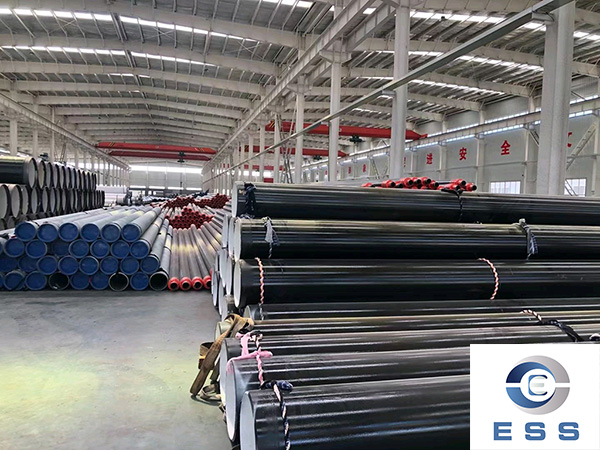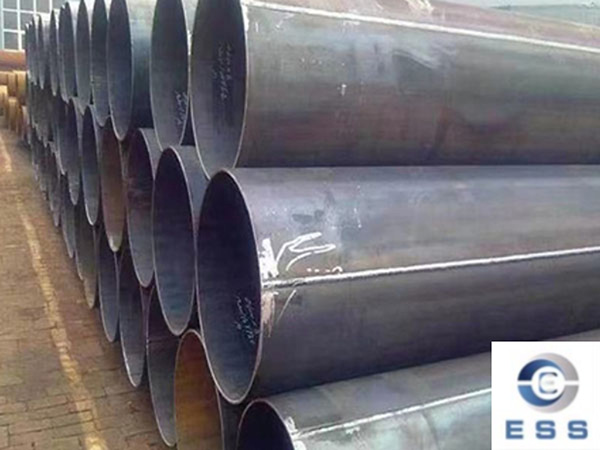Seamless pipe process
The seamless steel pipe is rolled by piercing the solid tube blank. According to different production methods, it can be divided into hot-rolled tubes, cold-rolled tubes, cold-drawn tubes, extruded tubes, etc.
1.1. Hot-rolled seamless pipes are generally produced on automatic pipe rolling units. After checking and removing surface defects, the solid tube blank is cut into the required length, centered on the perforated end face of the tube blank, then sent to the heating furnace for heating, and pierced on the piercing machine. Spin and advance the solid blank inside the process of piercing holes under the influence with the roller as well as the end. Then the solid blank is hollow finally, which is called gross pipe. Send to the automatic pipe rolling machine to continue rolling. Finally, the wall thickness is adjusted by the equalizing machine, and the size is sized by the sizing machine to meet the specification requirements. It is a more advanced method to produce hot-rolled seamless steel pipes by using continuous rolling mills.
1.2. If you want to obtain seamless pipes with smaller size and better quality, you must use cold rolling, cold drawing or a combination of the two. Cold rolling is usually carried out on a two-roll mill, and the steel pipe is rolled in an annular pass formed by a circular hole groove with variable cross-section and a stationary tapered plug. Cold drawing is usually carried out on a single-chain or double-chain cold drawing machine of 0.5-100T.
1.3. Extrusion method The heated tube is placed in a closed extrusion cylinder, and the perforated rod and the extrusion rod move together to make the extruded part extrude from the smaller die hole. This method can produce steel pipes with smaller diameters.

The production process of straight seam
Welded pipe is simple, the production efficiency is high, the cost is low, and the development is rapid. The strength of the spiral welded pipe is generally higher than that of the straight seam welded pipe. It can use a narrower billet to produce a welded pipe with a larger diameter, and it can also use a billet of the same width to produce a welded pipe with a different diameter. The weld length is increased by 30~100%, and the production speed is lower.
Welded pipes with large diameter or thicker diameters are generally directly made of steel billets, while small welded pipes and thin-walled welded pipes only need to be directly welded by steel strips. Then after a simple polishing, brushing on it.
Welded pipe process
Raw material decoiling - leveling - end shearing and welding - looper - forming - welding - inner and outer bead removal - pre-calibration - induction heat treatment - sizing and alignment - eddy current testing - cutting - hydraulic inspection - pickling - final inspection (Strict control) - packaging - shipment.

seamless vs welded pipe
This material of seamless steel pipes is prone to three quality problems in production: cracks, heavy skin, and slag inclusions. The occurrence of cracks is related to the centrifugal pouring process, and the pouring rule is unreasonable; the heavy skin is related to the pouring temperature and pouring speed; the slag inclusion is related to the content of metal chemical elements and slag removal treatment.
The prevention and control measures of seamless steel pipe manufacturers are as follows:
1. Improve cold rolling equipment to effectively prevent cracks
Reduce the residence time of precision seamless pipes at high temperature, and strengthen the effect of inoculation, especially flow inoculation. The amount of inoculant added is controlled to be 0.1-0.25% of the steel billet; to ensure uniform distribution of pipe mold powder, the amount used to control the inner surface of the pipe mold is 20-30g/m2. Control the smelting process parameters of the water-cooled metal centrifuge.
The centrifuge should prevent the billet from splashing due to the vibration of the launder, and the socket sand core should be placed properly to avoid burrs. Control the billet composition, reduce the silicon content of the billet, and it is advisable to control W (Si) at 0.8-1.2% after pouring into the nodulizer. The circular arc-shaped spray cooling pipes are evenly arranged in the casing of the centrifuge, and they are arranged in sections to avoid the mutual influence of cooling water in each section.
Ways to increase the success rate of welded pipes
1. To control the burning of oxide skin in the heating furnace, the workshop is required to strictly control the heating temperature of the Q215 billet at 1050-1150 degrees, and the heating furnace temperature at 1260-1280 degrees;
2. Continuously monitor the overall operation of the heating furnace. When the temperature of the billet entering the furnace is high, appropriately reduce the amount of gas and air entering the heating furnace, reduce the concentration of oxidizing gases in the furnace, and reduce the occurrence of overburning.
3. Aiming at the problem of rolling waste caused by piled steel, on the one hand, the loader is required to check the quality of the steel billet in time to reduce the amount of starting material into the furnace; Cutting is carried out to reduce the impact of the first billet on production.













 Eastern Steel Manufacturing Co.,Ltd not only improve product production and sales services, but also provide additional value-added services. As long as you need, we can complete your specific needs together.
Eastern Steel Manufacturing Co.,Ltd not only improve product production and sales services, but also provide additional value-added services. As long as you need, we can complete your specific needs together.











